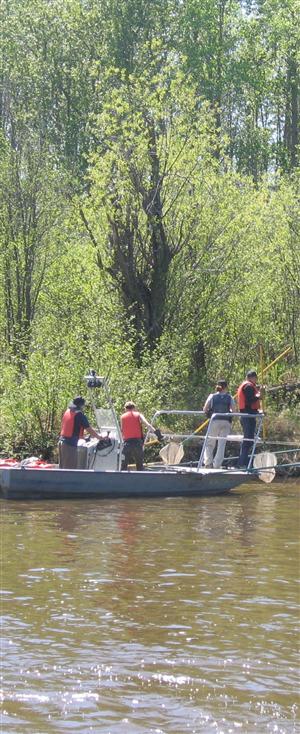Monitoring Components
Each year, RAMP collects information about key components of the aquatic environment through field sampling and the collection of various samples for laboratory analysis. These data, together with information collected over previous years by RAMP and other organizations, are analyzed to better understand the characteristics of the natural aquatic environment and to assess any potential changes in the environment that have occurred. A brief summary of each environmental component studied by RAMP is found below; for more detailed information on each, click on the highlighted headings.
Summary. For a summary of which water bodies (rivers and lakes), that RAMP monitors, please refer to the Monitoring Summary by Component page.
Climate and Hydrology. Climatic data, such as precipitation, air temperature, and snowpack measurements, are collected at sites throughout the RAMP study area. RAMP also monitors changes in the quantity of water flowing through regional rivers and stream, as well as water levels in selected lakes within the region.
Water Quality. Water quality is assessed in rivers, creeks, lakes, and wetlands within the study area in order to better understand natural water quality conditions, and to determine the potential exposure of living organisms (e.g., fish) to various chemicals and water quality conditions.
Benthic Invertebrate Communities and Sediment Quality. Benthic invertebrates are small organisms, such as bugs, that live in the bottom substrate of lakes, rivers, and creeks. RAMP collects information on benthic invertebrates in waterbodies throughout the study area, as these communities of bottom-dwellers serve as biological indicators of aquatic ecosystem health. Sediment quality is a key influence on aquatic biological communities; RAMP collects data on sediment composition (e.g., % sand, silt, and clay) and quality (e.g., chemical content) in conjunction with benthic invertebrate community sampling.
Fish Populations. RAMP monitors fish populations—including species abundance, growth, and tissue quality—in rivers and lakes. Fish are an important biological indicator of ecosystem health and integrity, and are also a highly-valued resource in the Athabasca oil sands region.
Acid-Sensitive Lakes. Water quality in regional lakes that are sensitive to acidification is monitored as an early warning indicator of potential effects related to deposition of acidifying emissions.
Aquatic Vegetation. Early in the RAMP, aquatic vegetation was monitored in a few select lakes. The program was discontinues in 2004 following a decision to place greater emphasis on monitoring water quality, sediment quality and benthic invertebrates in these lakes. All historical information and data regarding the aquatic vegetation component can be found in the Annual Technical Reports from 1997 to 2003.
To view the RAMP sampling locations for each monitoring component, along with watershed and lease boundaries, view the Monitoring Locations Interactive Map.









